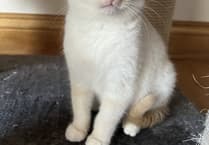This article first appeared in the Isle of Man Examiner of March 22.
I spent an interesting evening last week with Chris Morgan who had seen the photo on here of the Isle of Man Children’s Home in the early 1950s.
He had some very interesting stories to tell, not only of his time in the home but how despite his difficult start in life went on through lots of hard work to be successful. He was able to identify a number of the children in the photograph seated around Mr and Mrs Brookfield.
For most of his life Chris had blocked out his early childhood experiences but in later years had extensively researched via newspaper reports and online not only his own family circumstances but the subject more generally. He was able to share with me a photograph of the then named ‘Isle of Man Home for Orphan and Destitute Children’ from 1949 with 46 boys and girls on it and a number of others including the one published here on February 22.
He didn’t recall all the names as his memories were more of those children in his age group but his recollection extended to many others.
In only the broadest terms from top to bottom of the photo Edna Potts, Jean Dickinson, over a few to Muriel Kenna, Tommy Faragher, skip again to John Chambers, Michael Carrane, John Christian, Ronnie Kewley, next row down Maureen Brookfield, Doreen Christian, Doreen and Marjorie Quiglini, Dennis Evans, Noel Boyd, Bobby Moore (who had raised the original enquiry with me), David Joughin, Derek Christian, Michael Quiglini, next row Barbara Trotter,Alan Faragher, Maureen Cowin,Dorothy Christian, John Curran, Christopher Morgan, Geoffrey Evans, Brian Kinnish, and the front row Joan Christian, Valerie Martin, Valerie Crellin, Doreen O’Gleenin, Leslie Dickinson and Brian Archibald.
My sincere apologies for any misspelt names and for those missed but the photo is about 70 years old!
Chris recollected that the principal reason so many young people were resident in the children’s home was abject poverty on the island at that time.
He remembers seeing a farmer’s wife docking turnips without any footwear which was fairly commonplace for children as well during this period in our history.
He spoke of the soup kitchen in Myrtle Street and of his memories as a very young child being placed in the children’s home.
After the Brookfields, in charge of the home came Mr Greaves.
He recalls the bath regime and ill treatment as a matter of course for some of the children, who may not have been angels but certainly did not deserve the sometimes harsh conditions after being separated from parents or siblings.
He recalls some of the great and the good of Douglas being trustees and attending the home to check on the children with those in charge smiling and putting a positive spin on the situation.
His first memory as a two-year-old was looking to the ceiling from his resting place and seeing a pale blue light which afforded very little illumination, a memory that has remained with him since.
He also spoke of other children who had been resident at the same time as himself who had gone on to take their own lives or be alcohol-dependent whereas his chosen solution was to bury himself in his work.
He recalls being marched to the Bethel Church, in a group of more than 50 children, which was opposite where the Raglan pub in Circular Road was, the site then became a garage and told me Lorne House in Castletown was once used as a children’s home as well.
I didn’t know that, remembering clearly though the one at Ramsey.
He also shared a photo of Glencrutchery Road with TT bikes in the 1950s being assembled for the start and in it you can clearly see the young people from the home packed against the wall watching the proceedings.
They would have been only 20 feet away from the excitement which must have been a sharp contrast from everyday life for these little ones. Like Bobby he also recalls spending happy times with Mr Vick the gardener who he recalls being a kind man.
A number of people were genuinely kind and supportive of the children including a number of ladies from the telephone exchange who would collect money in the busy hotels and other places to provide some special things including three Christmas presents.
When Chris was 14 he became a crew member on the Steam Packet vessel Tynwald he had to return to the children’s home aged 16 but then went on to serve in the merchant navy.
He recalls working as a young man in very cold and sparse conditions in a Birkenhead dry dock whilst work was carried on over winter on a Steam Packet boat but thankfully due to his hard work which perhaps provided an outlet for his adverse childhood experiences he turned his life around.
It was a pleasure meeting him and his wife Claire and I thank him for his openness about his difficult early years.
........................
It never ceases to amaze me the quality of local theatrical productions and talent hosted at Frank Matcham’s masterpiece, The Gaiety Theatre.
My friend Graham Crowe, winner of three Cleveland Medals in the Manx Music Festival (the Guild, coming soon, don’t miss it) and a winner at Blackpool and Southport festivals, like me and many others attended Sweeney Todd presented by the Manx Operatic Society last week.
Who remembers the memorable performance of Tony Hawkes in the title role some years ago?
With the kind permission of Graham, I recite here his excellent critique of the latest production.
After the huge success of Douglas Choral Union’s recent Hunchback of Notre Dame, the Manx Operatic Society had to bring their A game to the Gaiety Theatre with their offering of Sweeney Todd, and they most certainly did with another West End-standard production.
Following so soon after the glorious lush and multi-layered melodic harmonies of Hunchback, Sondheim’s complex and challenging score couldn’t have been a greater contrast.
Billed as a musical thriller there were for me also intriguing elements of horror panto!
A great set, costumes and staging led the audience straight back to the old days of London town.
The show was superbly cast throughout and David Artus was totally mesmerising as the title character, absolutely nailing yet another iconic role in his commanding style.
Gemma Varnom was equally brilliant as Mrs Lovatt, and the double-handed scenes were so incredibly well judged.
Impressive memory feat from both too,with some long and extremely wordy songs.
Alex Toohey brought an especially obnoxious and sinister presence as Judge Turpin, and his interactions with the barber were also a definite highlight.
Neil Callin as his sidekick Beadle Bamford,had an element of panto baddie to lighten the mood.
Lovely vocals too from Hannah Clinton (Johanna) and Alex Maxwell ( Anthony) playing the love struck couple.
Cory Corkill most definitely a name to remember for his engaging portrayal of Tobias.
The show was characterised by the creative flair and attention to detail of John Cumberlidge throughout.
The very strong ensemble were superbly coordinated with many memorable cameos within it,and impressive lower register singing from bass / baritone members. I especially enjoyed Marie Quinn’s beggar woman.
It was a long show, but the company maintained their concentration and intensity,holding the audience’s attention throughout.
Congratulations to all those involved behind the scenes and to Martin Heywood and the orchestra for some brilliant work.
It’s definitely not one I’d take my grandkids to, and I’m very glad that that I cut my own hair and shave myself. I think I’d be too traumatised to sit in a barber’s chair now!
The barber’s chair is one of the best props I’ve seen on the Gaiety stage. Oh – and I think I’ll be sticking to A & J Butchers pies too!




